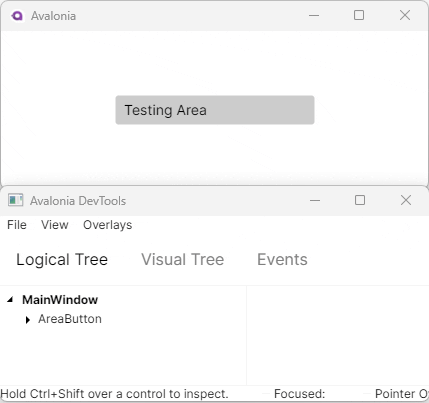伪类(Pseudoclasses)
概览
Avalonia中的伪类,类似于CSS中的伪类,是由Control(控件)暴露出的关键字,用于方便地指示控件的特定状态,以便于样式选择器使用。这些状态被用于条件性地样式化控件。例如,一个Button(按钮)在被按下时可以有不同的外观,一个 TextBox 在被禁用时也是如此。
伪类状态通过控件的PseudoClasses属性进行跟踪。按照惯例,伪类名称以冒号开头,例如:pointerover 或:pressed 。
选择器用法
以下示例展示了如何在CheckBox被选中时应用粗体文本:
<Window.Styles>
<Style Selector="CheckBox:checked">
<Setter Property="FontWeight" Value="Bold" />
</Style>
</Window.Styles>
<CheckBox Content="Pseudoselectors" />
一个控件可以同时激活多个伪类,此时您可以用选择器同时目标多个伪类。例如:
<Style Selector="Button.red:focus:pointerover">
上面的选择器针对具有red样式类,并且同时具有:focus和:pointerover伪类状态的Button控件。
通用的伪类
以下伪类由InputElement定义,所有控件均可访问。
| Pseudoclass | Description |
|---|---|
:disabled | The Control is disabled and cannot be interacted with. |
:pointerover | The Pointer is over the Control as determined by hit testing. |
:focus | The Control has focus. |
:focus-within | The Control has focus or contains a descendant that has focus. |
:focus-visible | The Control has focus and should show a visual indicator. |
可访问性
PseudoClasses集合是一个受保护的属性。这种访问限制阻止了通过代码后置(code-behind)和附加行为外部设置现有和自定义伪类。因此,自定义必须通过继承来实现。
自定义伪类
在创建自定义控件时,您可以定义自定义伪类来暴露控件状态。[PseudoClasses]特性向IDE提供了您的伪类信息。这种行为是可继承的,因此自定义控件会自动受益于其基类控件定义和管理的伪类(如InputElement的:pointerover)。
以下示例定义并在指针悬停在Button的不同区域时设置伪类。
- C# Control
- Example XAML
- ControlTheme XAML
[PseudoClasses(":left", ":right", ":middle")]
public class AreaButton : Button
{
protected override void OnPointerMoved(PointerEventArgs e)
{
base.OnPointerMoved(e);
var pos = e.GetPosition(this);
if (pos.X < Bounds.Width * 0.25)
SetAreaPseudoclasses(true, false, false);
else if (pos.X > Bounds.Width * 0.75)
SetAreaPseudoclasses(false, true, false);
else
SetAreaPseudoclasses(false, false, true);
}
protected override void OnPointerExited(PointerEventArgs e)
{
base.OnPointerExited(e);
SetAreaPseudoclasses(false, false, false);
}
private void SetAreaPseudoclasses(bool left, bool right, bool middle)
{
PseudoClasses.Set(":left", left);
PseudoClasses.Set(":right", right);
PseudoClasses.Set(":middle", middle);
}
}
<Window.Styles>
<Style Selector="local|AreaButton">
<Setter Property="Content" Value="Testing Area" />
<Setter Property="MinWidth" Value="200" />
<Style Selector="^:left">
<Setter Property="Content" Value="Left" />
</Style>
<Style Selector="^:right">
<Setter Property="Content" Value="Right" />
</Style>
<Style Selector="^:middle">
<Setter Property="Content" Value="Middle" />
</Style>
</Style>
</Window.Styles>
<local:AreaButton />
<ControlTheme
x:Key="{x:Type local:AreaButton}"
BasedOn="{StaticResource {x:Type Button}}"
TargetType="local:AreaButton" />

注意
当使用由其父级定义的ControlTheme创建简单的派生控件时,会使用StyleKeyOverride。在本例中,由于Button是一个TemplatedControl,因此有必要创建一个ControlTheme,因为选择器必须针对AreaButton来指定新的伪类。